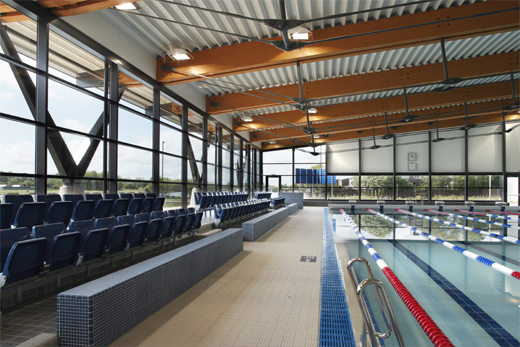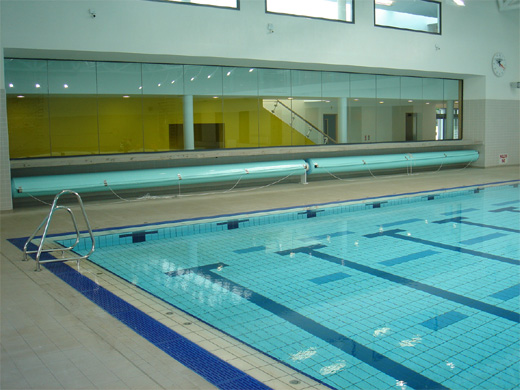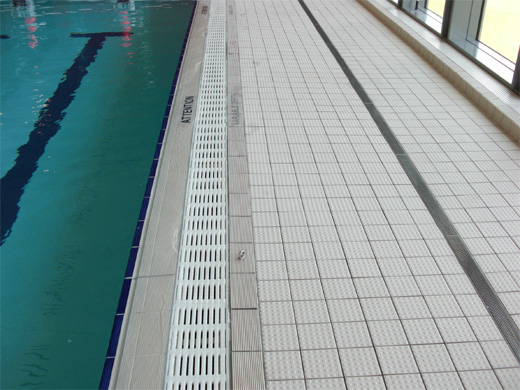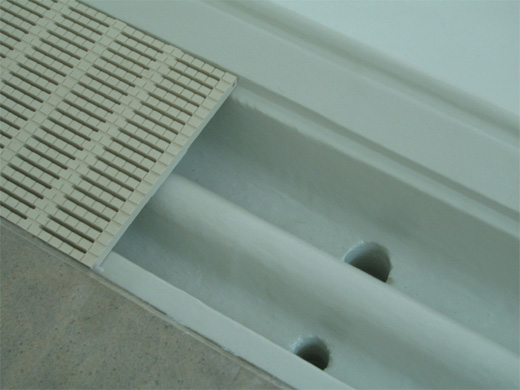The introduction of BS EN 15288 has made a significant difference to pool surround drainage. Internationally-respected Aquatic Consultant Tom Devin of Devin Consulting discusses the implications.
For over thirty years the standard design approach to pool surround drainage has been to slope the pool deck into the transfer channel. Major public sector projects with this detail include the Manchester Aquatic Centre, the London Aquatic Centre for 2012 and the National Aquatic Centre, Dublin. Many pool operators have developed their operating procedures on the basis of this design approach – both their Normal Operating Procedures (NOP) and Emergency Action Plan (EAP) – to maintain the pool surrounds in a clean and hygienic condition while taking due care of the pool water quality. The Pool Water Treatment Advisory Group (PWTAG) guidelines have also consistently acknowledged this design approach, with guidance on a range of issues.
There are two parts to the new standard:
- BS EN 15288-1: 2008 Swimming pools Part 1. Safety Requirements for Design
- BS EN 15288-2: 2008 Swimming pools Part 2. Safety Requirements for Operation.
Both were published in January 2009.

Killingworth Pool - a high quality approach to pre BS EN 15288 design, successfully used throughout the UK and Europe
BS EN 15288-1:2008 states under clause 5.6.1 Pool Surrounds:
“The pool surround shall also be designed to avoid contamination of the pool water by water flowing on the floor (e.g. rain in outdoor pools; water dripping from the users; floor/gutter washing water; chemicals in washing water).
Note 2: For deck level pools, this can be achieved if the floor slopes away from the overflow channel and to a drain to waste. It should be possible to divert the overflow channel to a waste-drain to lead the washing water to waste. For skimmer pools, this can be achieved by raising the pool edge (e.g. by a coping).”
While it is unfortunate that some of the clarity of the above clause has been lost in the translation, the message and spirit of the standard is clear – the pool surround design should by itself provide a higher level of protection to the pool water quality.
This guidance in 15288-1 is contrary to traditional swimming pool design and operation in the UK, and at the time of its preparation objections were raised by a number of UK organisations. However the guidance is now firmly in place and key questions are being asked about how to address it.
Standards have no legal status in themselves but are meant as guidance to enable designers and operators to fulfil their obligations of “duty of care” under the Health & Safety at Work Act 1974.
The new BS is an attempt to set a minimum standard across the European Union. Where the standard is more or less onerous than an existing national standard or accepted best practice, for example the PWTAG 2009 publication Swimming Pool Water – Treatment and Quality Standards for Pools and Spas or HSG 179 Managing health and safety in swimming pools published by the Health & Safety Executive , then the most onerous standard should be used.
While one is not legally obliged to comply with published standards, should an incident or problem arise that was related to the non-compliance, then the organisation or body responsible for the decision to work outside of the standard would need to be able to demonstrate that their decision was based on appropriate and sound criteria. A risk assessment could be one way of approaching this.
Risk assessment
The issue of deck level surrounds sloping towards transfer channels and the potential contamination of pool water is not new, and is addressed in several publications, with some of the guidance going back many years. The PWTAG 2009 guide provides advice on a number of cleaning issues:
- Pool surrounds should be cleaned daily by washing and scrubbing (if required) with pool water only
- Any proprietary cleaners used should be suitable for poolside use and not affect the pool water by interfering with chemical balance or reacting with pool water chemicals or interfering with monitoring
- If unsuitable chemicals have to be used for cleaning the pool surrounds and will be washed into the deck level transfer channel, or cleaning the deck level transfer channel itself, the design of the pool should allow the deck level transfer channel to be isolated from the balance tank and its contents discharged to waste.
A key element in all of this is that pool surrounds should be regarded as clean areas with access strictly limited to staff with the appropriate footwear and to bathers who have been through the pre-swim showers. The surrounds should not be subject to dirty traffic, e.g. persons with outdoor footwear, and if such persons do wish to use the pool surrounds they are required to wear plastic overshoes.

Traditional pool surround detail at Tallaght Pool, Dublin
HSG 179 requires a written Pool Safety Operating Procedure, which requires an NOP to be produced. The NOP should set out the way the pool operates on a daily, monthly and yearly basis and should contain the routines relating to the cleaning of the pool surrounds and the deck level transfer channels.
BS EN 15288-2:2008 Swimming pools Part 2: Safety Requirements for Operation also refers to cleaning and disinfecting the premises, in particular pool surrounds in clause 6.1.5:
“Procedures shall include how to select proper detergents and disinfecting agents. Manufacturer’s advice shall be followed etc…
Chemicals used to clean the pool surround shall not adversely react with the chemicals used in the pool water. Particular attention shall be paid to avoid contamination of pool water by detergents and disinfectants, which could also affect the pool water control devices.”
With reference to clause 5.6.1, a risk assessment of “… contamination of the pool water by water flowing on the floor…” could consider:
- The water for daily washing of the pool surrounds, which would normally be pool water or tap water, neither of which would be regarded as detrimental to the pool water
- The water dripping from bathers, either pre-swim which could contain soap residues, or post-swim which would only be the pool water itself, but both of such negligible amounts relative to the pool water volume
- Deep cleaning of the pool surrounds with chemicals to remove body fats, hardness salts and general dirt, but using compatible chemicals and cleaning equipment to remove water with cleaning residues
- Water which may be used to clean the pool surrounds after an abnormal occurrence involving say blood, vomit or faeces, will have specific operational procedures for each occurrence
- Provision of a dedicated drain within the transfer channel to isolate, if required, water flows from the balance tank.
The new Standard
Compliance with the new Standard requires that water on the pool surrounds does not end up in the pool. This requires a separate drainage channel into which the pool surrounds slope. The channel could be located adjacent to the transfer channel (a double channel), on the outer edge of the pool surround or somewhere in between. The channel could take the form of a dished tile with gulley or an ACO type channel.

BS EN 15288 compliant pool surround with central ACO channel at Cambletown pool, Scotland
Compliance with 15288-1 should consider the four areas of water quality, design, construction cost and operation:
Water quality:
- In theory there should be an improvement as all washwater will go direct to waste, including residues from deep cleaning
- Risks of pool water contamination from pollutants on the pool surround should be significantly reduced
- In practice if a pool with the surround sloping towards the transfer channel was well run, then there may be little or no difference to one compliant with the new BS.
Design:
- Sloping the pool surround away from the transfer channel or using a double channel will require a different design approach to the one used and developed over the last thirty years
- The design will be more complicated as it will require two drainage channels as opposed to one
- The performance of the transfer channel and the cover grille is critical, as any water carry over would wet the pool surround and go to waste
- Diving pool air cushion water surge will need to be considered
- The use of dished tiles as drainage channels will need to take account of wheels on wheelchairs.
Cost:
- Compliance with the standard will be more costly due to the second channel and associated drainage pipework
- Budget costs for the additional works on a 25m pool could range from £20,000 for a dished tile solution, to £40,000 for an ACO channel solution if the surround slab needed to be cranked.
Operation:
- Water carry out by bathers will go to waste, so there will be increased water loss; an allowance of 0.5 litres/bather/swim is suggested
- Daily pool surround wash down water will go to waste; while this may be good for water quality there will be more water loss
- Chemical cleaning of the pool surrounds can go directly to waste, making this process easier
- Faeces, blood or vomit on pool surrounds can be washed directly to waste, making this clean up process easier
- The second channel will require maintenance in terms of cleaning and also ensuring that the water traps do not dry out, potentially allowing sewer odours into the building
- Care will still be required in the selection and use of cleaning chemicals to avoid contamination of the water; the design approach should not be seen as a means for less stringent operation procedures.
Summary
There are both advantages and disadvantages with the two options for pool surround slopes, i.e. sloping into the pool water transfer channel or sloping to a separate drainage channel.
The former approach is widely recognised by the statutory, advisory and sporting organisations, is well understood in terms of design, construction and operation, and is widely used in the UK and Ireland, backed up with appropriate NOPs and EAPs. A risk assessment of this approach could be considered for its use on new projects.

Bath Spa twin channel option utilising epoxy coated preformed concrete profiles
The new approach in 15288-1 will require new details for design, construction and operation, will cost more, will result in greater water loss from the pool, should make the overall cleaning process easier and may result in an improvement in pool water quality.
As the new standard affects both design and operation, any decisions regarding the standard should address the views of both the designer and operator. The designers of the above pools include Donnelly Turpin, FaulknerBrowns, Grimshaw-Architects, and S&P Architects.

